|
Monday, March 1, 2010
Progress Notes
For many years, as long as I can remember when driving through Mead’s Flat on Highway 54 going west toward the Dam, I have seen a sign on the east end of the valley indicating the creek over which the highway crossed was named “Wright's Creek” (photo 01).
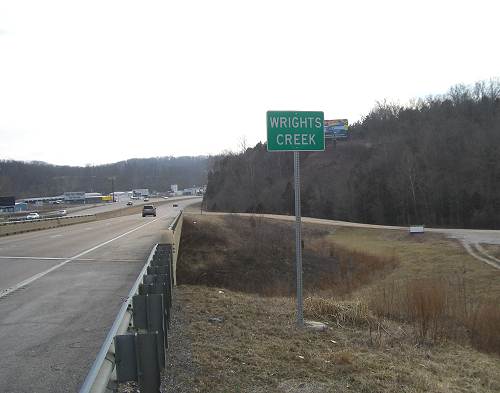
01 Wright's Creek Sign I always wondered if the creek was named after the same family of Wrights which settled in the Little Saline Creek valley north of Tuscumbia. So the other day I called Hershel Cotten of Eldon who I knew had roots in that area to tell me the story of how the creek was named. I didn’t know it before calling but I certainly had called the right person. You see, the Wright after which the creek was named was Hershel’s great grandfather, Ezekiel Wright, and yes, he was of the same family of Wrights who lived north of Tuscumbia. Hershel, who has devoted the last twenty years to organizing multiple genealogical studies having to do with his heritage, has traced the Miller County Wright family back to Peter Wright born in 1570 in the town of Yorkshire, England. Anthony Wright is the original Wright who came to mid Missouri from back east accompanied by many of his children. Anthony settled in Cole County near Brazito where he was buried. Several of his children ended up in Miller County. Of note, the male children of Anthony who came to Miller County were James Lawrence Wright, Ezekiel Wright, and Hiram Wright. Many of their descendents today still live in the county.
Hershel has more than fifty thousand names of family antecedents and relatives in his computer data base. He also has hundreds of obituaries collected including all those acquired by his cousin, Gaylord Strange, with whom he cooperated in building their mutual obituary files. Here is a photo of Hershel sitting at his computer the other day when I visited him (photo 02):

02 Hershel Cotten Hershel’s mother, Nellie Wright, who was married to his father, Joe Cotten, was the daughter of Oris Cordell Wright, who was the son of Ezekiel, the Wright who settled in the Wright Creek valley. Here is an old photo of Ezekiel and his wife, Susan Barlow Wright which Hershal has in his collection (photo 03):
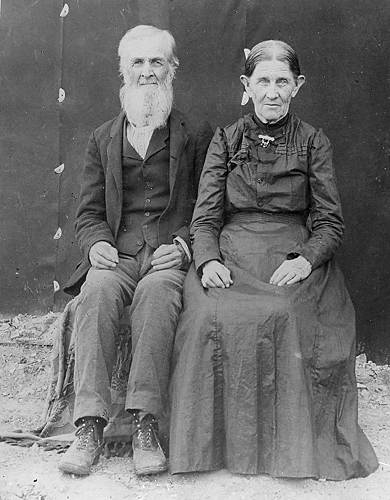
03 Ezekiel Harker Wright and Susan Barlow Wright Ezekiel’s son, Oris Cordell Wright, was the one who owned the Wright farm around the turn of the last century (I’m not sure how it came to him as Ezekiel had three other sons and nine girls). Here is a photo of Oris and his wife, Rhoda June Barlow Wright (photo 04):
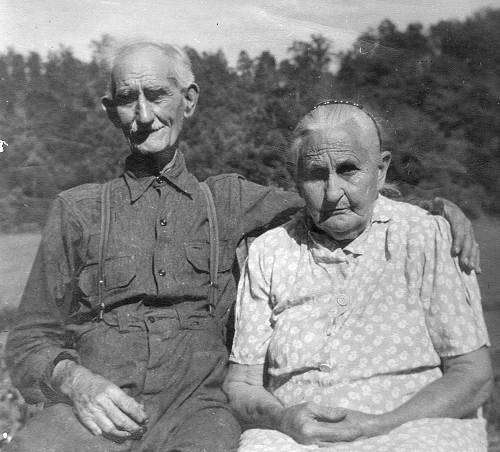
04 Oris Cordell and Rhoda June Barlow Wright And here is a plat map of the Wright Creek area indicating where the Wright farm was located which is in section 4 (photo 05):
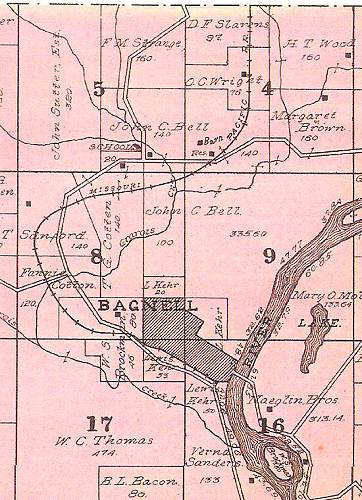
05 Plat Map T40N - R15W
Click image for larger viewOris gave an interesting account of his early life living on Wright Creek which was published by the Eldon Advertiser in 1954:
Oris Cordell Wright Tells of Early Bagnell Line
Eldon Advertiser, January 21, 1954
Oris Cordell Wright was only ten years old when the Bagnell Branch of the Missouri Pacific railroad was being constructed between Eldon and Bagnell. On December 14 he was 84 and probably is the only person who has lived on the same farm bordering the line since its beginning.
Mr. Wright, who is still spry for his age, lives eight miles south of Eldon about half the distance to the dam.
He loves to retell stories of early Miller County history, and he especially likes to tell the joke on himself when mule teams were scraping out the roadbeds at the Bagnell Branch.
Old Bill Bagnell was busy building the road past the Wright property, the Ezekiel Wright place, when Oris, who was ten years old at the time, overheard the men speaking of rails. “This is a real opportunity to make some money,” he figured.
So, Oris approached the foreman and asked, “Mister, how about a job splitting rails?” The inquiry met with some laughter. The youngster had never heard of the rails used by trains. He thought the men were speaking of the type Abe Lincoln had split.
But pay was not so good in those days when compared to that of today. The workmen using blasting powder on the rock bluffs received only $1.50 per day.
The railroad was completed to Cooper Station nearly two years before it was continued to the end of the line. The construction of the Cooper Station to Bagnell was finished by Bill Bagnell (photo 06). He agreed to grade the switch bed at the end of the line if the place would be named for him. It thus became known as Bagnell.
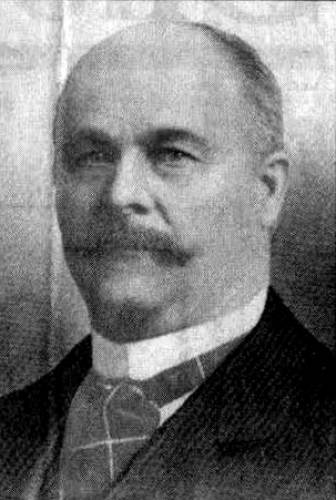
06 William Bagnell A labor camp was located on the old Fletch Slavins place. One worker died of pneumonia and was buried in Gravois Creek.
The first train on the line stopped near the Wright place and people from the entire area gathered to inspect the new machine. The children were crowded up close and Jim King, fireman, pulled the whistle cord. Everyone scattered, including Oris.
But the whistles are gone now along with the railroad and only memories of yesteryears remain along the once booming Bagnell Branch.
Jewell Oris Wright, son of Oris Cordell Wright, also gave an interview to the Advertiser sometime in the mid 1960’s. By this time his father, Oris Cordell Wright, had died October 13, 1958 at the home of his daughter, Grace Hill, in Decatur, Indiana from heart disease. He was buried at the Tol-Wood Cemetery near the old Wright farm beside his wife, Rhoda Barlow Wright, who had died March 18, 1950.
Jewell Oris Wright Visits Mac at Advertiser
By Madolyn McFarland (approximately 1960’s)
Anybody remember the town of Adelaide? We don’t…and neither did Jewell Oris Wright presently living in Kansas City who dropped in at the office to visit with us last week. But Mr. Wright, who owns a farm off Highway 54 in the Bagnell community where he regularly spends time also, recalled the stories he’s heard his father, the late Oris Cordell Wright, tell.
Note: you can read about the community of Adelaide on our website.
Jewell Oris related the way the town of Bagnell was named according to a story often heard from his father, Oris Cordell Wright.
Before the extension of the Jefferson City, Lebanon and Southwestern Railroad (later the Missouri Pacific) to Miller County in the early 1880’s there was a community on the north side of the Osage River, just upstream from present Bagnell, by the name of Adelaide.
Turnaround point for the branch line from Jefferson City was where the present community of Bagnell is located. Among residents nearby was Bill Bagnell, according to the way Wright’s story goes. He wanted the new community named for him so he asked the railroad to name the spot “Bagnell.”
His request didn’t meet with an enthusiastic response, but then he offered to make and deliver all the big switch ties needed there by the railroad if the town would bear his name.
And so it became Bagnell.
The University of Missouri bulletin, “Our Storehouse of Missouri Place Names” by Robert L. Ramsey, published in 1952, agrees the Miller County town was named in 1882 for William Bagnell.
Bagnell was listed as among nearly 30 place names in Missouri borrowed from the names of railroad officials, operators, employees and directors in keeping with the enormous part played by the coming of railroads in the growth of the state.
Jewell Oris Wright told us other bits of history passed down by his father, Oris Cordell Wright, who was a resident throughout the history of the railroad in Miller County.
“He was living on the farm when the railroad went through, and still there when the Missouri Pacific finally removed the rails and stopped the line.”
Oris Cordell Wright, a boy of 12 when the Bagnell Branch line was laid, often told of the first train engine’s arrival at Eldon. Everyone gathered around to see it, but when the engineer blew the whistle, the unexpected sound frightened the spectators.
Oris Cordell Wright died in 1957 at the age of 87, but his son still has the farm, now 180 acres in size, which has been in the family about 100 years.
“I guess I’ll keep it for my grandchildren,” he said.
Jewell Oris Wright’s grandfather, Ezekiel Wright, once had a grist mill and a saw mill there.
“The outline of the big pond is still visible. The big stone burrs, with square centers, for the grist mill long remained on the farm until Oris Cordell Wright gave them away,” he said.
Jewell Oris Wright, recalled the story about the days when his grandfather, Ezekiel Harker Wright, came here. Most of the houses then were log cabins. His grandfather proceeded to build “a strictly modern lapsided house.” When it was completed, he gave a party, and people came from miles and miles to see a lapsided house”.
Many recall that Oris Cordell Wright sold Spitz dogs at his home off Highway 54. The fondness for dogs apparently is a family trait as Jewell and his wife take their pet dog along wherever they travel.
Jewell Oris Wright formerly was a box maker in Kansas City but now retired he and his wife devote their time to traveling.
I thought it interesting that, as Jewell noted above, Ezekiel Wright had built a water powered grist mill just as his brother James Lawrence Wright had done on the Little Saline Creek many years ago.
Here is a photo of Oris Cordell and June Barlow Wright with their three children including Jewell, who gave the interview to the Advertiser above (photo 07):
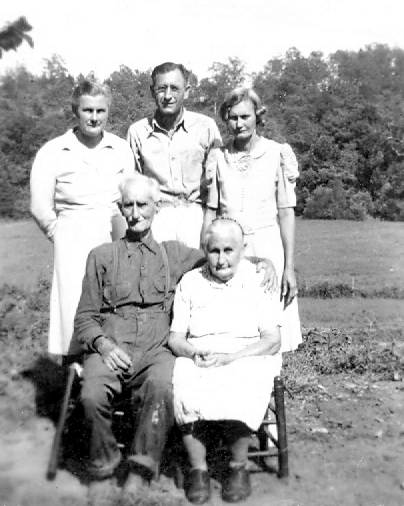
07 Nellie Winfred, Jewell Oris and Grace Wright
Children of Oris Cordell and June Barlow Wright Nellie Wright, also in the photo, was the mother of Hershel Cotten. Here are another couple of photos of Oris Cordell (photo 08) and June Barlow (photo 09):
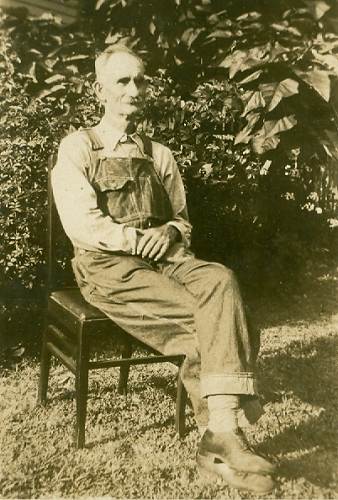
08 Oris Cordell Wright
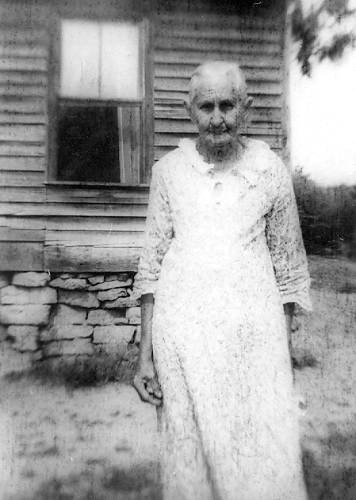
09 Rhoda June Barlow Wright In a previous edition of Progress Notes, Pauline Vaughan Stanton, who was born and raised a few miles north of the Wright farm and knew the family well, offered some interesting memories:
At the Wright's Creek bridge going in the direction of Eldon via the railroad was the Wright homestead. Longtime back and when it was autumn, Mr. Arey (Oris) Wright was often seen with his horse drawn wagon laden with hickory nuts and black walnut and other wares making his sales trips. Seated beside him in the spring seat of the wagon was his faithful White Spitz. The Wrights raised White Spitz's for sale but gave up each puppy with reluctance. When the two Union Electric villages were new settlements, Mr. Wright and his dog were often seen going door to door like an early day peddler, but his wares were not bottled or boxed. He also made his way across Bagnell Dam to the new town of Lake Ozark and the man and his dog were recalled long after the sales trip became a bit of local history.
During my childhood, we were often invited to the Wright home and it was tradition to go there for lunch when mulberries hung ripe on the tree and be served mulberry cobbler. The tree was of such proportion and the area it shaded so extensive that one felt it must have stood in that location since time began. In the corner of the vegetable garden was a large planting of horseradish and Mrs. Wright shared roots with my mother. Chopping onions can bring tears to the eye but cannot compare to grating horseradish.
Daughter Grace recuperated from tuberculosis in the home. Health care procedures were faithfully adhered to and Grace recovered to live to an old age. To my knowledge, no one else in the neighborhood fell victim to the disease at that time. Mr. and Mrs. Wright were the age of my grandparents and it was a special treat to visit their home. Mr. Wright wore a bushy white mustache and my grandpa Vaughan a bushy red one and I suppose to a child that denoted some kind of kinship.
You can read more of what Pauline remembered about the Wright Creek area where she lived at this previous Progress Notes from 2007.
As Pauline indicated above, Oris Cordell Wright was fascinated with White Spitz dogs. You can read more about this breed at this website.
Here are a number of photos of Oris Cordell with his White Spitz dogs (photos 10, 11 and 12):
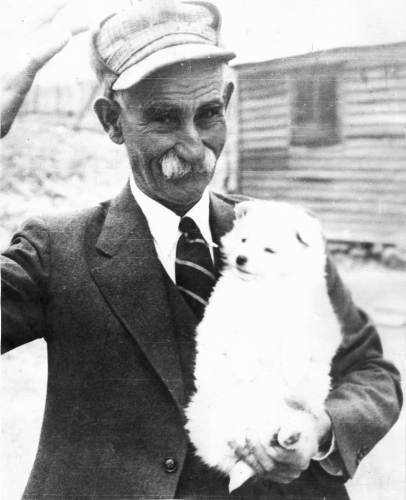
10 Oris Cordell Wright and White Spitz Dog
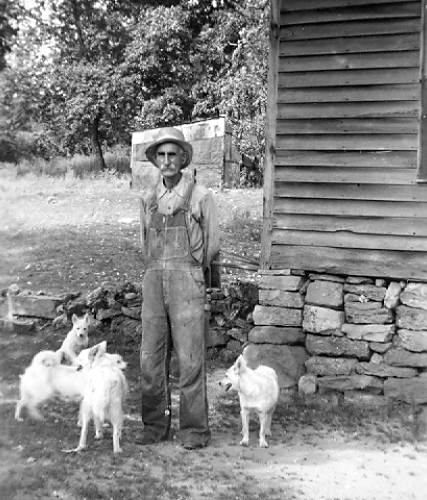
11 Oris Cordell Wright and White Spitz Dogs
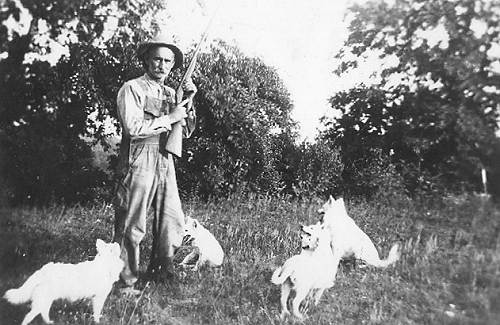
12 Oris Cordell Wright Going Hunting And here is a group photo of the grandchildren of Oris Cordell Wright including Hershel Cotten (photo 13):
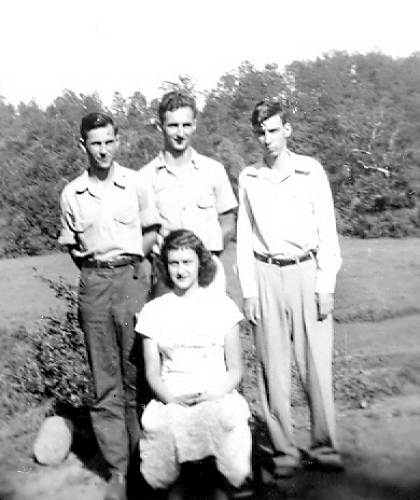
13 Paul, Davy, Herschel and Lila
Grandchildren of Oris Wright - 1948
Hershel, grandson of Oris Cordell Wright, was born in Kansas City in 1930 but his parents, Joseph William Cotten and mother, Nellie Winfred Wright, returned to their Miller County home when he was a young teenager. They lived on forty acres rented to them by Oris Wright, father of Nellie, on a share cropping arrangement. Hershel attended School of the Osage high school his junior and senior years being graduated in 1949. Afterward, he returned to Kansas City and worked in a carton box factory while attending various schools at night learning electronics. These included Central Technical Institute, Radio Telephone Technician School, and DeVry Institute (photos 14, 15 and 16).
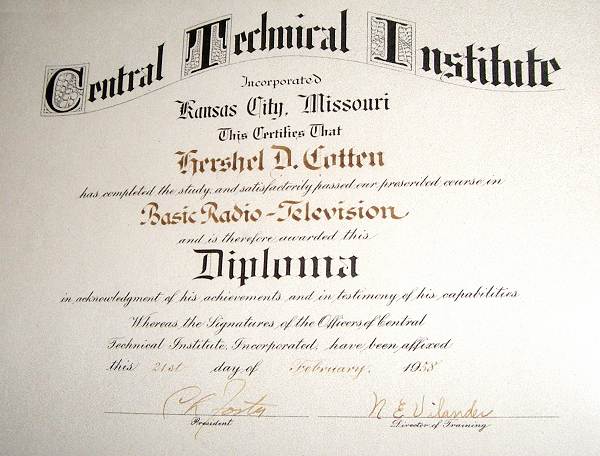
14 Central Technical Institute Diploma
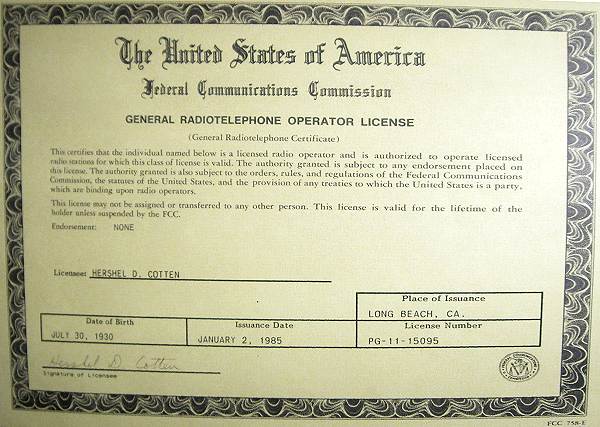
15 Radiotelephone Operator License

16 DeVry Technical Institute Diploma He has these diplomas framed and proudly hanging on his office wall. He also has his Junior High diploma earned in Kansas City framed and placed on the wall (photo 17).
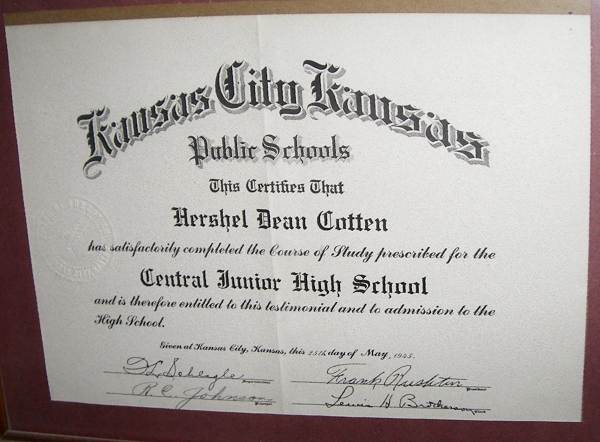
17 Junior High School Diploma But Hershel says he is most proud of his High School diploma from School of the Osage (photo 18).

18 School of Osage Diploma For a few years Hershel operated some small businesses in Kansas City but wasn’t satisfied with his future there. Therefore, he decided to seek employment in his field of Electronics in Los Angeles to where he moved in 1965. He joined TWA as a technician with the responsibility to diagnose electrical malfunctions on the passenger airplanes. One benefit of working for TWA was the opportunity to fly anywhere in the world for free. Hershel took advantage of this company policy by visiting many countries and most of the continents of the world.
Hershel retired in 1987 and returned to Miller County now living in Eldon. He has many interests but most of all, as I remarked earlier, he enjoys the hobby of genealogy having many albums of family histories and photos. He also collects obituaries. Hershel says he has over fifty thousand names recorded in his computer with family histories. The majority of these are family members and their progeny. However, marriages have brought many names to his database in addition to blood relatives.
Hershel continues to care for forty acres of the original Wright farm he inherited from his mother, Nellie Winfred Wright, which is located a short distance from Highway 54 about a quarter mile upstream on Wright Creek.
I asked Hershel if he would give me a short tour of the Wright farm so a week or so ago we drove over there.
The road to the farm is sharply to the right off the west bound lanes of Highway 54, just past the Wright Creek sign. The farm road is secured by a locked gate but once past the gate it becomes clear that the gravel road follows precisely the old Missouri Pacific Railroad track going north toward Cooper Station. Hershel told me he spent several thousand dollars repairing and building up the old track line road bed. We exited the car at the original Ezekiel Wright home site, later the home of his son, Oris, which now is mostly covered by blackberry bushes. Hershal stood at the site of where the old home once was located, the one Jewell described above that was unique in being the only “lapsided” home in the area, built by his grandfather, Ezekiel (photo 19).
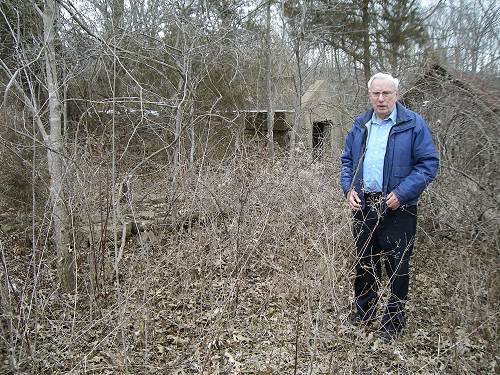
19 Home Site of Oris and Ezekiel Wright In photos 09 and 11 above you can see portions of the old “lapsided” home built by Ezekiel.
The pipe leading to the old hand dug well was still present (photo 20), and the cellar is in very good condition (photo 21).
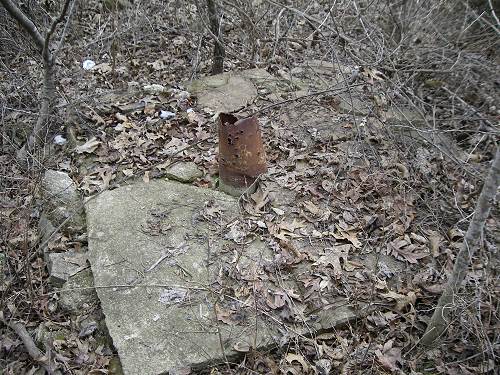
20 Hand Dug Well on Oris Wright Farm
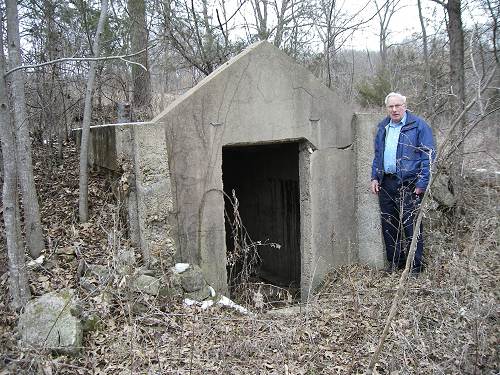
21 Store Room for Vegetables The old hen house is standing also (photo 22).
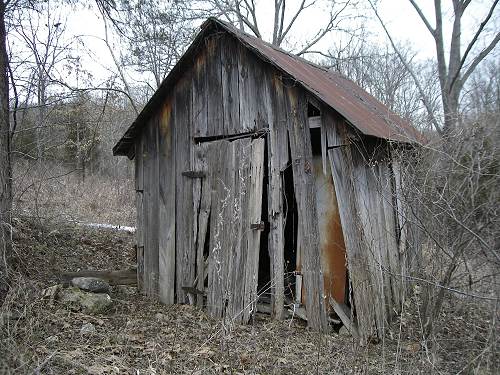
22 Chicken House Two huge trees are still standing between which was tied a homemade hammock (photos 23 and 24).
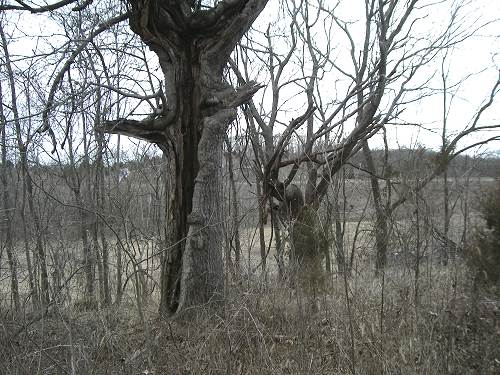
23 Ancient Trees in yard of Oris
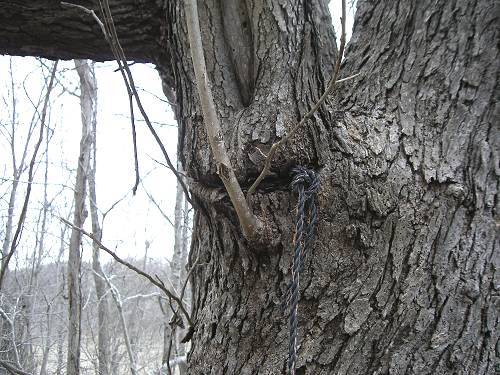
24 Rope for Swing I forgot to ask Hershel if one of these old trees was the "mulberry tree" mentioned by Pauline Vaughan above.
A little farther north was the old home site where lived Hershel’s parents, Joe and Nellie Wright Cotten. Hershel in this photo is standing where the house once was but no longer is standing (photo 25).
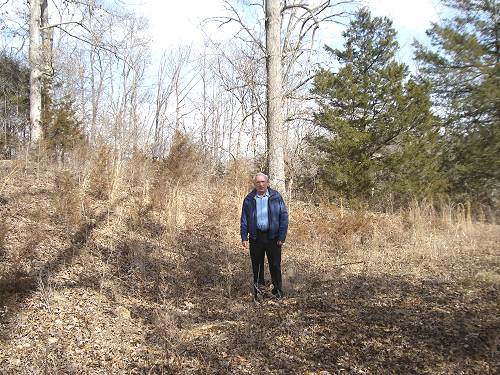
25 Home Site of father Joseph Cotten The old hen house has a window made from a Model A car windshield (photo 26).
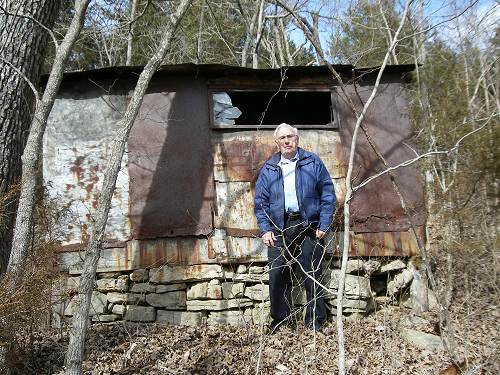
26 Chicken House - Window is from Model A Inside one can see that the support for the roof is made from tree saplings (photo 27).
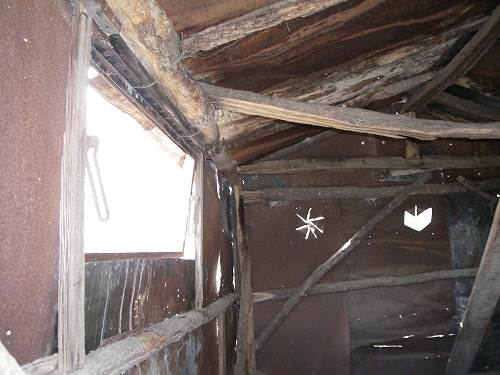
27 Inside Chicken House The old hog house is still present although fallen (photo 28).
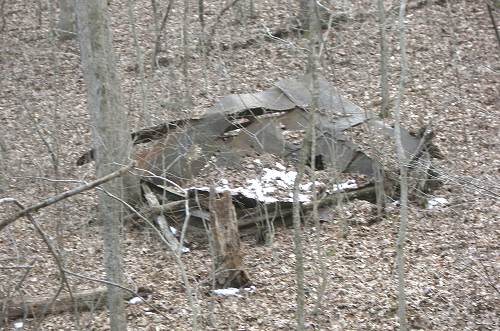
28 Hog House on Hershel's father's Farm Hershel told me the draw where the hog house was located had a lot of arrowheads. Also, he found evidence of old molten galena lead suggesting that the Indians may have known the technique of using lead for various items, maybe even arrowheads!
The well piping is still present also (photo 29).
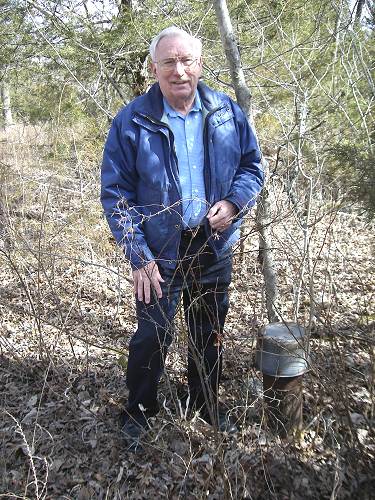
29 Dowsed Well Hershel says this well was located by “Dowsing.” You can read more about this fascinating technique for locating a well, once very often utilized, at this article on Wikipedia.
I want to thank Hershel for his kindness in taking the time to share with me all the photos and memories of his Wright family ancestors. I especially am grateful to Hershel for giving me a personal tour of Wright Creek valley and the historic Wright family farm, which still is owned by the family and more than eligible for Century Farm status. In fact, Hershal told me that his next project was to gather the documentation necessary to have the state approve the Wright Creek farm for Century Farm designation.
This week’s entry from the diary of C.B. Wright is from the months of September and October in the year 1912 (photo 30).
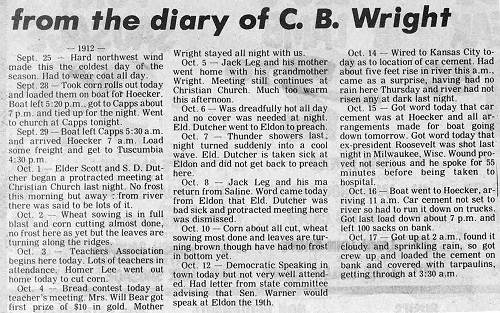
30 C.B. Diary - Sep and Oct 1912
Click image for larger viewIn this photo of C.B. he is accompanied by his cousin, Tennyson Clay Wright (photo 31).
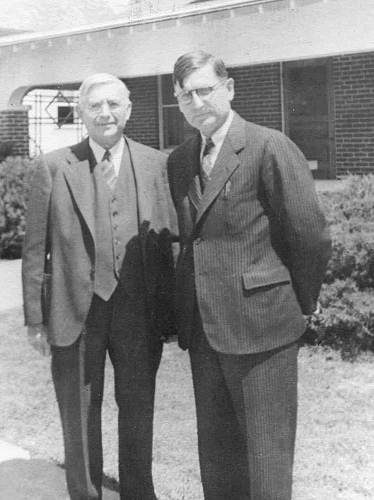
31 Clarence Boyce and Tennyson Clay Wright Both shared the same grandfather, James Lawrence Wright, one of the original Wrights to come to Miller County (James was a brother to Ezekiel Wright discussed above in the story of Wright’s Creek). C.B.’s father was Green Lee Wright and Tennyson’s father was James Pinkney Wright, brother to Green Lee. Tennyson Clay was the most highly respected educator ever to have taught at the Tuscumbia school system. You can read his story in a previous Progress Notes.
Scroll about half way down the page to find the section about Tennyson Clay Wright.
In the diary this week for the date October 4, 1909, C.B. mentions that “Mrs. Will Bear got first prize of ten dollars in gold.” William Bear was the son of John Bear and was a member of the county court in 1909 when this photo was taken (photo 32).
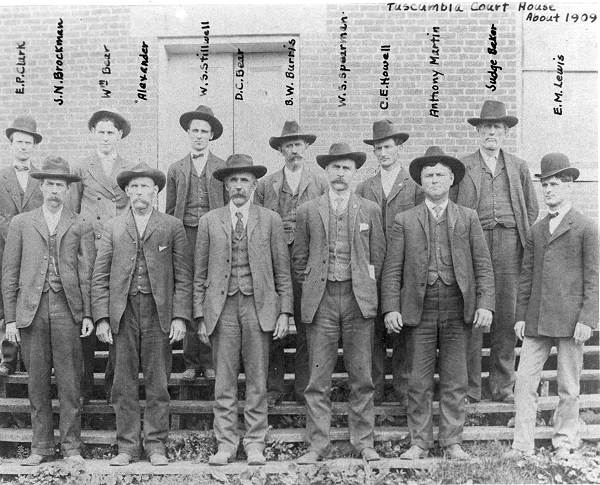
32 County Court - 1909 - First Man on Left Bottom Row: John Blackburn
Click image for larger viewWilliam is second from the left in the back row. In the first row third from the left is standing William’s uncle, David Christian Bear, a brother to John Bear. David was the presiding judge at the time. An error in the photo names the first gentleman on the left in the front row John Brockman. However, the correct name is John Blackburn. The building behind the group is the old brick Miller County Courthouse. The next year, in 1910, this court accomplished the task of getting bonds passed to fund the construction of the large stone courthouse which was used until about six or so years ago when the current courthouse on Highway 52 north out of town was finished (photo 32a).
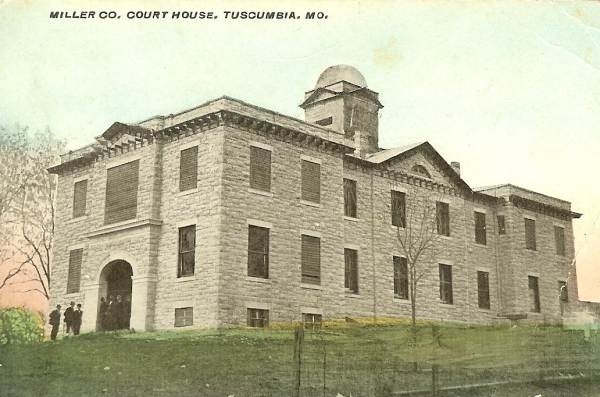
32a Miller County Courthouse - 1910 Here is the cornerstone of the south entrance to the old courthouse naming the officers of the county court at the time the building was constructed (photo 33).
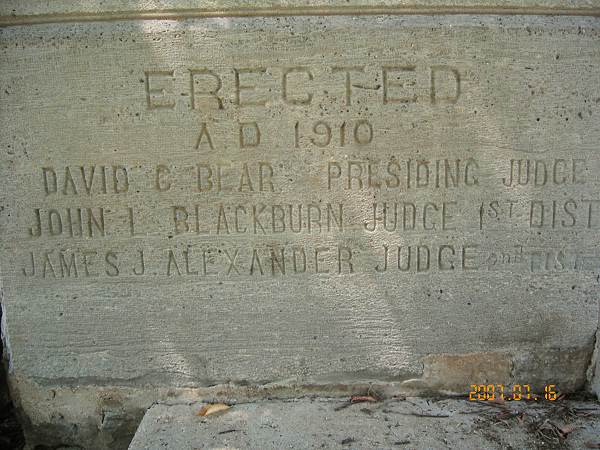
33 Cornerstone at the Courthouse David Christian Bear was my great grandfather and John Bear my great great uncle. William would have been my third cousin.
For the date of October 5 C.B. writes: “Jack Leg and his mother went home with his grandmother Wright.” Here C.B. is referring to his son, Homer Clay Wright, who at the time would have been about two years old. Here is a photo of Homer at that approximate age (photo 34):
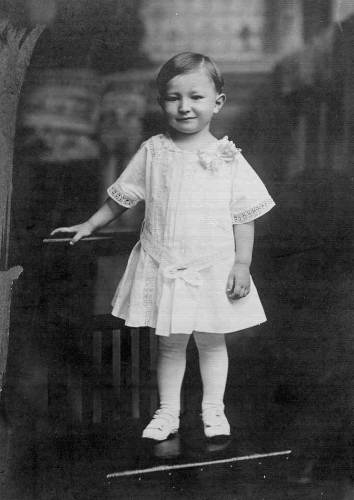
34 Homer Clay "Jack Leg" Wright as baby 2 Years 8 Months I’m sorry but no one today I can find knows why C.B. referred to Homer as “Jack Leg.” However, online one finds that the term is not especially flattering:
adj.
- Lacking skill or training; incompetent. Used especially of lawyers or preachers.
- Unscrupulous or dishonest.
- Makeshift; temporary.
n.
- An unskilled or unscrupulous itinerant worker.
- A strikebreaker.
Well, since Homer was C.B.’s only child and since he named a steamboat after him, I can’t imagine he really held such a low opinion of the future president of the Anchor Milling Company.
For the date of October 12, C.B. mentions that “Senator Warner (photo 35) would speak at Eldon the 19th.”
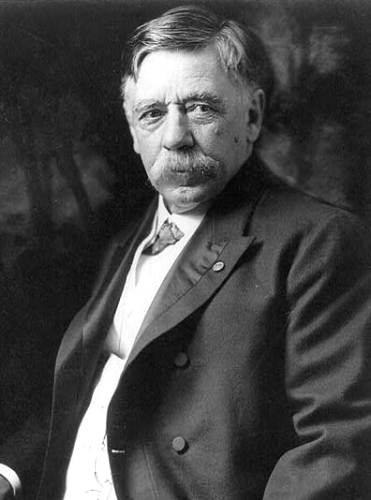
35 Senator William Warner Senator Warner was a Missouri U.S. Senator from 1905 to 1911, so he would not have been in office in 1912 when this diary entry was written. Probably, he continued to be addressed as Senator as a note of respect after leaving office. He has an interesting history which I will copy here from Wikipedia:
William Warner (June 11, 1840 – October 4, 1916) was an American lawyer and politician from Kansas City, Missouri. He represented Missouri in both the U.S. House and Senate. He was mayor of Kansas City in 1871-72.
He was born in Shullsburg, Wisconsin, in Lafayette County, Wisconsin. His parents died in his youth, and he was raised by his sister, Mary Ann Warner Webb and her husband, Joseph Webb. He studied law at Lawrence University and the University of Michigan at Ann Arbor; admitted to the bar in 1861.
He enlisted in 1862 as a 1st Lieutenant in the 33rd Wisconsin Volunteer Infantry Regiment; was mustered out at the close of the Civil War with the rank of major in Madison, Wisconsin and moved his practice to Kansas City. He was city attorney in 1867; circuit attorney 1868; Kansas City Mayor in 1871; elected as a Republican to the Forty-ninth and Fiftieth Congresses (March 4, 1885-March 3, 1889); was not a candidate for renomination in 1888; elected commander in chief of the Grand Army of the Republic in 1888; unsuccessful Republican candidate for Missouri Governor in 1892; United States district attorney for the western district of Missouri 1882-1884, 1898, 1902-1905; unsuccessful Republican candidate for governor of Missouri in 1892; elected as a Republican to the United States Senate in 1905 and served from March 18, 1905, to March 3, 1911; was not a candidate for reelection; chairman, Committee on the Mississippi and its Tributaries (Sixtieth and Sixty-first Congresses); resumed the practice of law; appointed as civilian member of the Board of Ordnance and Fortifications; member of the Board of Managers of the National Home for Disabled Volunteer Soldiers. His widow, Sophia, received a pension until her death in 1932.
Here is the obituary of Senator Warner as printed in the New York Times in 1916 (photo 36):
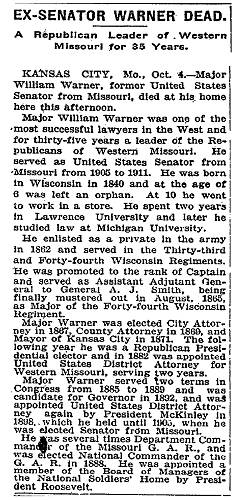
36 Senator Warner Obituary - N.Y. Times - 05 OCT 1916
Click image for larger viewIn the entry for October 15, C.B. writes, “Got word today that ex President Roosevelt was shot last night in Milwaukee, Wisconsin.”
The attempted assassination of President Theodore Roosevelt was something I didn’t know much about. Maybe you didn’t either. Here is the story I copied from the internet:
Teddy Roosevelt Shot by Anarchist
Manuscript of Speech Saves His Life
Introduction and research by:
R. J. Brown
Editor-in-Chief
A question in a trivia book lead me into researching this article. The question was: "Which president's life was saved due to a speech he had prepared?" A little blurb on the card explained that Teddy Roosevelt was about to give a speech when an assailant ran forward and fired a shot. Due to the thickness of the manuscript of the speech, it acted as a deterent and slowed the bullet down enough so that it only pierced him -- a sort of bullet-proof vest if you will. A quick trip to the library and I was able to find on microfilm a copy of the October 15, 1912 edition of the Detroit Free Press. Right there on the front page was the news all about it. Printed here are transcripts of the text of the news accounts.
Milwaukee, Wis., October 14 -- A desperate attempt to kill Col. Theodore Roosevelt tonight failed when a 32 caliber bullet aimed directly at the heart of the former president and fired at short range by the crazed assailant, spent part of its force in a bundle of manuscript containing the address which Co. Roosevelt was to deliver tonight, and wounded the Progressive candidate for President.
Col. Roosevelt delivered part of his scheduled address with the bullet in his body, his blood staining his white vest as he spoke to a huge throng at the auditorium. Later, he collapsed, weakened by the wound, and was rushed to Emergency hospital.
Shot in Front of Hotel
The shooting took place in the street in front of the Hotel Gilpatrick. Col. Roosevelt reached Milwaukee shortly after 5 o'clock and making his way through the crowd which had gathered at the station, entered an automobile and was driven to a private dining room on the main floor with the members of the party on his private car.
After dinner Col. Roosevelt stood up, waving his hat in answer to the cheers of the crowd. The assassin was standing in the crowd a few feet from the automobile. He pushed his way to the side of the car and, raising his gun, fired.
Henry F. Cochems, former athlete and Chairman of the Progressive Party speaker's bureau, and Elbert Martin, Roosevelt's stenographer, seized the man and held him until policemen came up. John Schrank (photo 38), who is small of stature, admitted firing the shot and said that "any man looking for a third term ought to be shot.”
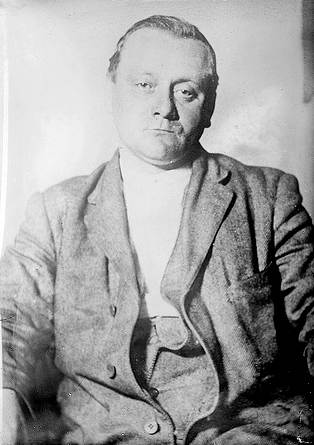
38 John Flammang Schrank Col. Roosevelt barely moved as the shot was fired. Before the crowd knew what had happened, Martin, who is six feet tall and a former football player, had landed squarely on the assassin's shoulders and borne him to the ground. He threw his right arm about the man's neck with a death-like grip and with his left arm seized the hand that held the revolver. In another second he had disarmed him.
All this happened within a few seconds and Col. Roosevelt stood gazing rather curiously at the man who attempted his life before the stunned crowd realized what was going on.
Col. Roosevelt refused to allow doctors to examine him at first. Later, doctors made an examination of the wound and announced "Col. Roosevelt is suffering from a superficial flesh wound. Bleeding was insignificant. He soon traveled on to the Auditorium where he was scheduled to give a speech."
Bullet Perforates Manuscript
The manuscript of his speech doubtless had done much to save his life. When he had come upon the platform at the Auditorium he drew the manuscript from his vest pocket during his first few words, the torn sheets of paper, showing many stains blood, showed also that the bullet had gone through the manuscript.
"You see," cried the colonel holding up the manuscript so that the audience could see the bullet hole through the sheets of paper, "It takes more than that to kill a Bull Moose."
Teddy Roosevelt will forever be remembered as one of the great American presidents of our government.
And now after a rather free floating mind wondering discussion of various subjects of personal interest I will end this week’s Progress Notes.
Hope you come back next week!
 Joe Pryor
|

